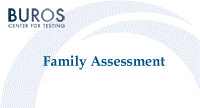Buros-Nebraska Series on Measurement and Testing
Date of this Version
1995
Document Type
Article
Citation
Family Assessment, ed. Jane Close Conoley & Elaine Buterick Werth (Lincoln, NE: Buros Institute of Mental Measurements, University of Nebraska-Lincoln, 1995).
Abstract
In the past several decades there has been a proliferation of interest and development of family systems theories. A unique aspect of a systems perspective is that human problems develop in and because of social interactions usually within the family, rather than solely from some internal process within an individual. A second innovation is the view that human behavior always occurs in a context, and that understanding the context is essential for understanding problem development and resolution. The empirical evaluation and validation of these perspectives has lagged behind theoretical and therapeutic developments. Further, research in this area has been hampered by a lack of reliable and valid measures of constructs of interest. During the 1980s there were significant developments concerning measurement issues and instrument development that facilitate the assessment of family relationships. This chapter will review and discuss issues and methods for assessing family health and distress.
THEORETICAL AND PRAGMATIC ISSUES IN ASSESSING FAMILY HEALTH AND DISTRESS
What is a Healthy Family?
There are as many definitions of healthy and dysfunctional families as there are theories of family functioning and family relationships (Gurman & Kniskern, 1981; Walsh, 1982). Although many of these theories overlap in their perspectives, there are unique aspects that are important to consider in describing healthy family processes. A complete review of theories of healthy families is beyond the scope of this chapter. However, a brief discussion of common aspects of systems approaches to families and family health is provided to orient the reader to basic assumptions of this approach.
A systems perspective to families views each family member as part of an interdependent interactional system that mutually influences other aspects of the family system. Change within one aspect of the system is believed to produce change in other parts of the family through a process of reciprocal feedback and shared meanings between family members. This is referred to as circular causality because the focus is on patterns of interactions rather than linear explanations of causality. The nonsummativity principle views the entire family as greater than the sum of the parts. It is essential to examine the pattern of relationships rather than just the pieces. Thus, assessing components or subsystems of the family system will not provide a picture of the whole family. All behavior within the family is considered communication that transmits interpersonal messages. Communication includes both the content of the messages and the process or how the messages are transmitted (Watzlawick, Beavin, & Jackson, 1967). Homeostasis refers to the mechanism by which the family maintains a steady state and equilibrium. Homeostasis is maintained through deviation-reducing feedback loops within the family, similar to how a thermostat regulates the temperature within a room. Morphogenesis is the process by which families change and adapt to internal and external demands. Positive feedback loops within the family that are deviation amplifying contribute to system change. Equifinality refers to the belief that systems may start at the same beginning, but may end with different outcomes because of system organization and response to the social and environmental context. Multifinality is the same principle in reverse; families can start with divergent beginnings and end with the same outcomes. Some systems approaches to families also view family functioning in a multigenerational perspective, with at least three generations considered (Bowen, 1978; Boszormenyi-Nagy & Ulrich, 1981; Kerr, 1981; Williamson & Bray, 1988). Learned patterns of relating, attitudes, unresolved emotional issues, and loyalties are presumed to be passed down through the generations and directly affect current family functioning.
Healthy families promote the well-being and functioning of each individual family member through the maintenance of clear and effective communication, mutually beneficial interactional patterns, clear boundaries between the generations and between family subsystems, and expectations that change over time to the internal demands of family members and external demands of the environment. A balance is maintained between the needs for family stability and change that promotes the health of individual family members. All families have problems as they go through transitions across the life cycle, and dysfunctional families have an inability to make these transitions without experiencing problems (Watzlawick, Weakland, & Fisch, 1974). "An ordinary family; that is, the couple has many problems of relating to one another, bringing up children, dealing with in -laws, and coping with the outside world. Like all normal families, they are constantly struggling with these problems and negotiating the compromises that make a life in common possible" (Minuchin, 1974, p. 6).
Included in
Educational Assessment, Evaluation, and Research Commons, Family, Life Course, and Society Commons, Quantitative, Qualitative, Comparative, and Historical Methodologies Commons


Comments
Copyright © 1995 by Buros Institute of Mental Measurements. Digital Edition copyright © 2012 Buros Center for Testing.